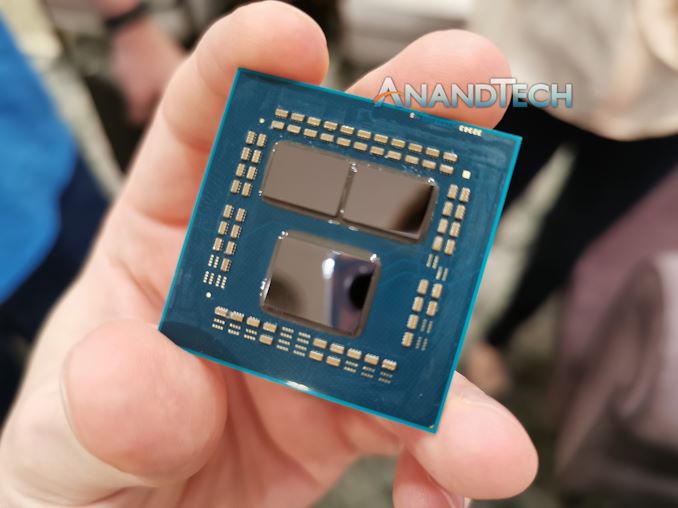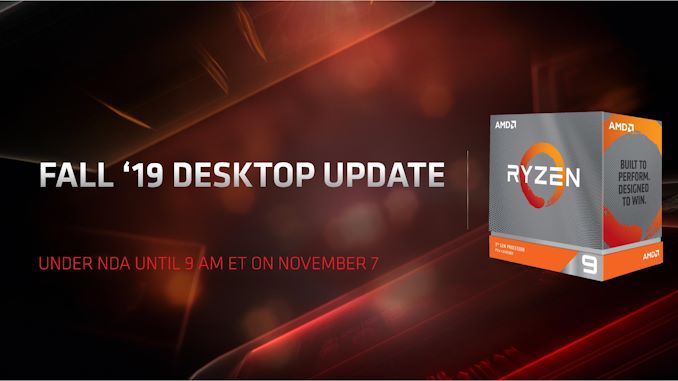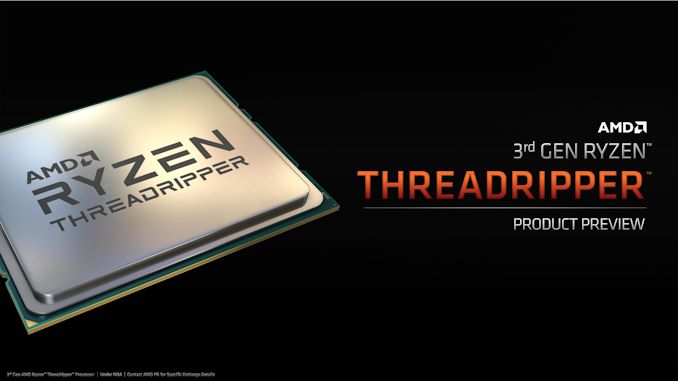AMD Q4: 16-core Ryzen 9 3950X, Threadripper Up To 32-Core 3970X, Coming November 25th
by Dr. Ian Cutress on November 7, 2019 9:00 AM EST
AMD is set to close out the year on a high note. As promised, the company will be delivering its latest 16-core Ryzen 9 3950X processor, built with two 7nm TSMC chiplets, to the consumer platform for $749. Not only this, but AMD today has lifted the covers on its next generation Threadripper platform, which includes Zen 2-based chiplets, a new socket, and an astounding 4x increase in CPU-to-chipset bandwidth.
This year AMD is presenting its ‘Fall 2019 Desktop Update’, covering the new products for the holiday season. Q4 is historically a good target for increased consumer sales, as long as the products hit the right price point and are available in volume for the peak shopping periods. We’ve been waiting mercilessly for more details about the crème-de-la-crème of what AMD has to offer with its 7nm product portfolio for both mainstream Ryzen desktop processors, but also the creator and workstation focused 3rd Gen Threadripper. After continuously requesting information from CEO Lisa Su since the middle of the year, AMD is lifting the lid on the product details, pricing, and launch dates.
The short version of today’s announcement revolves around several parts, in completely different markets.
- The Ryzen 9 3950X 16-core CPU for desktops
- Ryzen Threadripper 3rd Gen Family: Starting with the 24-core 3960X and 32-core 3970X
- New TRX40 motherboards for the new Threadripper Processors
- A new $49 Athlon 3000G for the entry level market
All of this hardware is set to come to market through the month of November at the following dates:
- Ryzen 9 3950X: Retail on November 25
- TR 3960X and TR 3970X on November 25th
- TRX40 motherboards on November 25th
- Athlon 3000G on November 19th
One key takeaway from today’s announcements is how AMD is moving the traditional desktop and high-end desktop markets. When CEO Dr. Lisa Su was asked earlier this year what will happen to Threadripper as the mainstream Ryzen family moves ‘up’ in performance, her response was that ‘Threadripper will move up-up’. To that effect, we are seeing AMD’s delineation between mainstream desktop and high-end desktop move up to between 16-core and 24-core, with room at the top for more cores if AMD wants to go that way.

Our Group Interview with Dr. Lisa Su at Computex 2019
This new hardware is also breaking new records for enthusiast CPU TDP values, as well as representing new ground on the latest 7nm process technology now available to the wider market. Details about pricing, TDP, AMD’s strategy, AMD’s performance numbers, TRX40 chipset information, and analysis of the announcements are all inside.












171 Comments
View All Comments
Spunjji - Friday, November 8, 2019 - link
Upgrading to a new Intel CPU also requires buying a new motherboard, and you'll only need to change RAM if you're going from DDR3 to DDR4 or your DDR4 is old and slow.Basically, AMD is a better value option and AM4 still has a potential upgrade path to Zen 3. Sounds like your "uninformed" comment is projection.
martinbrice - Thursday, November 7, 2019 - link
I'm really curious how the 3960X and 3970X might game. Sounds like architecturally with the single I/O die, they shouldn't suffer from the NUMA issues of the 2970WX or 2990WX. They're (essentially or precisely?) the same chiplets as the 3900X, but have a greater IHS surface area. Their advertised boost is competitive with 3900X, it'll be a matter of what they can hold as a steady state. They also have a larger cache.It'd be great if we could get all the benefits of the extra cores, PCIe lanes, and memory channels, without having to significantly sacrifice gaming performance.
Total Meltdowner - Thursday, November 7, 2019 - link
I was wondering the same thing. I game on an 1800x just fine at 1440p... This tr3 boosts 500mhz higher with about the same base clock...jospoortvliet - Sunday, November 10, 2019 - link
... and much better IPC. I would expect the TR's to beat your 1800x easily.abufrejoval - Thursday, November 7, 2019 - link
Adjustable cTDP is a godsent, but only if it is run-time adjustable (not just a fixed setting in the BIOS as with some older APUs) and preferably with command line and API: That allows you to really tune the hardware between energy efficient batch processing and fast interactive response times, especially when you can take cores offline similarly at run-time to make sure you hit high-frequency points consistently with the remaining ones (and re-enable them later).That would then turn most of the hundreds of fixed allocation SKUs Intel is selling into "CPU as code".
Of course these cTDP limits would have to be very closely observed (or be adustable), so you can control power vs. temperature limits, depending on if you want to allocate PSU overcapacity to increase boost speeds while there is thermal capacity or if you want a PSU that is energy optimzed, but has few reserves.
M O B - Thursday, November 7, 2019 - link
Why are the TRX40 motherboards all the same? Why aren't there different roles being played out with all of those PCIe lanes the motherboard manufacturer's are being given? Please make a motherboard for those of us who need lots of PCIe lanes and aren't just for gamers.With the TRX40 boards I see 4x PCIe slot on almost every single board--total. Some have a 5th slot, but is a x1.
I have been waiting for something like the X299 WS SAGE/10G to come out on the AMD side for more than a year, but apparently that day will never come.
Hammer_Man - Thursday, November 7, 2019 - link
The slide with the Threadripper prices, reads "New TRX40 Platform With 88 PCIe® 4.0"88 Lanes?
Dose the Chipset use a MUX och do the CPU have all those lanes?
DigitalFreak - Thursday, November 7, 2019 - link
They're probably playing the Intel game of adding the PCIe lanes on the CPU and the chipset together.Death666Angel - Thursday, November 7, 2019 - link
What's not to understand? It talks about the TRX40 platform, which is the chipset and the CPU as a whole and the article shows quite nicely what can be configured how. The CPU has 48 + 8 + 4 + 4 (=64) and the chipset has 8+8+4+4 (=24) which is the 88 number they come up with. 16 of those area already in use for the chipset communication, so 72 can be made available to the use however the motherboard manufacturer choose (as seen on the "AMD TRX40 Platform" slide). This isn't rocket science.pkv - Thursday, November 7, 2019 - link
Very disappointed by two things:(1) lack of retrocompatibility with x399
(2) no clear upgrade route for a setup with 16c/32t; from 1950x (999$) one could go to 2950x (899$); but now there's a 50% premium to go to the first TR40 offering (3960x 1399 $).
Going to 3950x+ x570 is not a solution when you need the pcie lanes provided by TR4.
@Ian: did you hear anything about a future 16c TR 3000, which would overlap with the 3950x obviously ? (Intel has done so in the past, mixing up HEDT and mainstream)